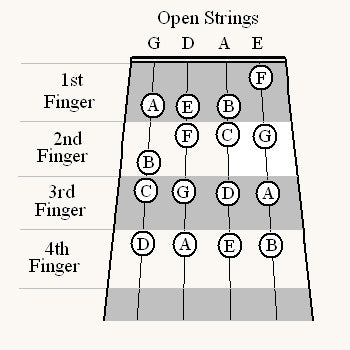The Natural Notes of the First Position
In western music we refer to seven named notes - A, B, C, D, E, F, and G. The following chart shows where these natural notes are fingered in the first position of the violin:


Note that there are more than one of each named note. There are three different Gs, for example, that can be played within the first position. Note also that it is possible to play notes between those indicated on the chart. For example, there is a space between the 1st finger F and 2nd finger G on the E string where the 1st finger could play an F# (F sharp). Sharped or flatted notes are not considered natural.
On the piano, the natural keys are white, while the sharped and flatted notes are black. Students of the violin do not have this advantage. We must memorize where the natural notes are played.
Many students wish to know why we use this somewhat random system of pitch names. It's an excellent question that touches on the physics of sound, how different frequencies combine and the resulting impact on our ears, the history of western music, how melodies and harmonies have evolved, and the history and evolution of western musical notation. By all means, read up on it - it's a fascinating study. But, if your goal is to lean to read music, allow me to encourage you to just accept and memorize the system we have.
